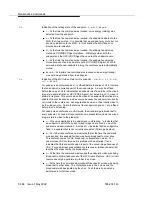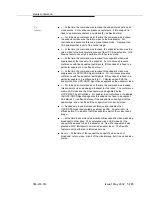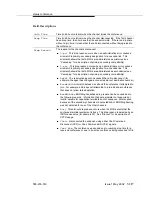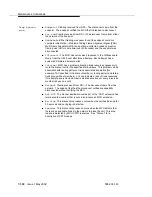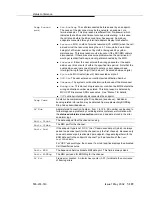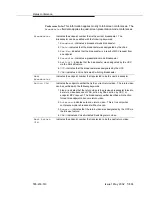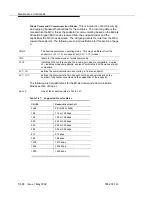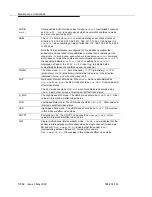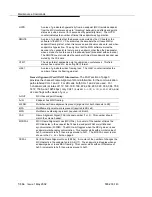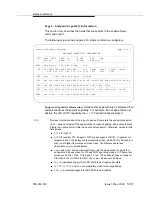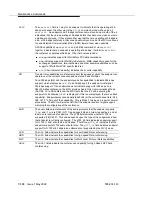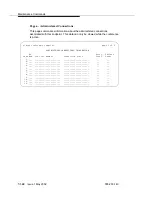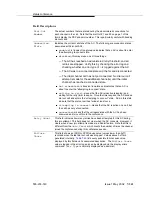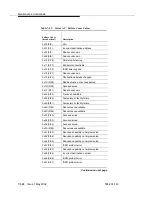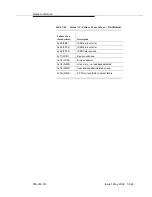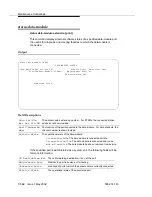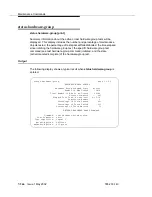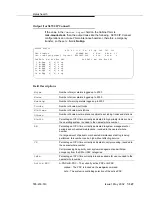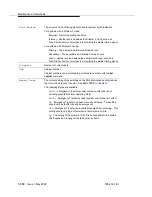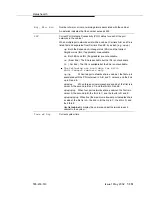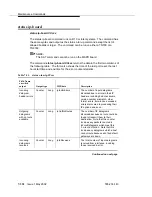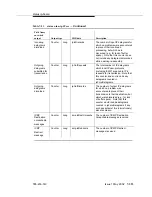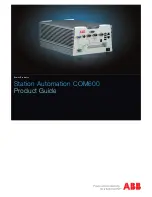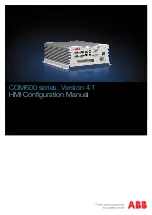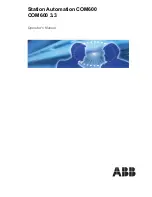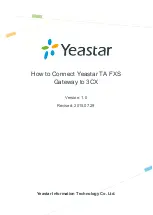
Maintenance Commands
555-233-143
7-338
Issue 1 May 2002
MISC
The
restrict
field is 1 way for an endpoint to indicate that it is operating at 56
kbps per channel, the other way is the
56/64
command mode with a value of
restrict
. An endpoint on a 56-kbps conference must send one or both of the 2
indications that they are operating at 56 kbps before they become a video source in
a 56-kbps conference. If they signal either way that they are operating at 56 kbps in
a 64- or 384-kbps conference, they are an audio-only source, but the MCU continues
to send Selected Communication Mode (SCM) toward them when possible.
A MISC capability of
derestrict
and a 56/64 command of
derestrict
together indicate that an endpoint is operating at 64 kbps. If either is
restrict
,
the conference operates at 56 kbps. Other field values include:
■
dcomp
indicates support for WorldWorx PCS data compliance.
■
mbe
indicates support for Multi Byte Extension. MBE capability is used for the
exchange of passwords, terminal names, and other special capabilities, such as,
support of WorldWorx PCS specific features.
■
cic
(Chair Indicate Capability) indicates chair control capability.
XR
Transfer rate capabilities are statement about the speeds at which the endpoint can
operate over the current connection and operate a Px64 Multiplex.
For a 384-kbps (H0) call, the endpoint sends its capabilities to indicate 384-kbps
support, which displays as
384
. On a 336-kbps call, the endpoint must signal
384-kbps support. If an endpoint does not indicate support for 384 kbps on a
384-/336-kbps conference, the MCU provides Audio Only Communications Mode
(ACOM). For a 2B conference, the MCU sets the rate to 2x64, expecting the
endpoints to do likewise (
64x2
is displayed; if this is not displayed, there is no 64x2
capability). Endpoints may occasionally take 2x64 (or the current channel rate: 384,
768, 1472, 1536) out of their capability. This is Mode 0 forcing and is part of normal
procedures. The MCU will provide AOCM if the endpoint does not signal support
matching the configuration of the conference.
AUD
The audio fields are statements of the audio protocols that the endpoint supports.
711m
and
711a
are PCM (G.711) and support Mu and A-law, respectively, and at
least one is required of endpoints. The g728 field indicates whether G.728 is
supported (LB_CELP). This value depends upon the type of the endpoint and how
that endpoint is currently configured. The g722_48 field indicates endpoint support
for G.722 (7 kHz) at both 48 and 56 kbps. Therefore,
g722_48
indicates that the
endpoint supports G.722 audio at both rates. The
g722_64
field indicates endpoint
support for G.722 at 64 kbps in an unframed (not supported by the MCU) mode.
LSD
The
LSD
fields indicate the capabilities for Low Speed Data conferencing.
HSD
The
HSD
fields indicate the capabilities for High speed Data conferencing.
MLP
The
MLP
fields indicate the capabilities for Multi Layer Protocol Data capabilities.
HMLP
The
HMLP
fields indicate the conference’s capability for High Speed MLP data
conferencing.
Summary of Contents for S8700 Series
Page 50: ...Maintenance Architecture 555 233 143 1 26 Issue 1 May 2002 ...
Page 74: ...Initialization and Recovery 555 233 143 3 12 Issue 1 May 2002 ...
Page 186: ...Alarms Errors and Troubleshooting 555 233 143 4 112 Issue 1 May 2002 ...
Page 232: ...Additional Maintenance Procedures 555 233 143 5 46 Issue 1 May 2002 ...
Page 635: ...status psa Issue 1 May 2002 7 379 555 233 143 status psa See status tti on page 7 406 ...
Page 722: ...Maintenance Commands 555 233 143 7 466 Issue 1 May 2002 ...

